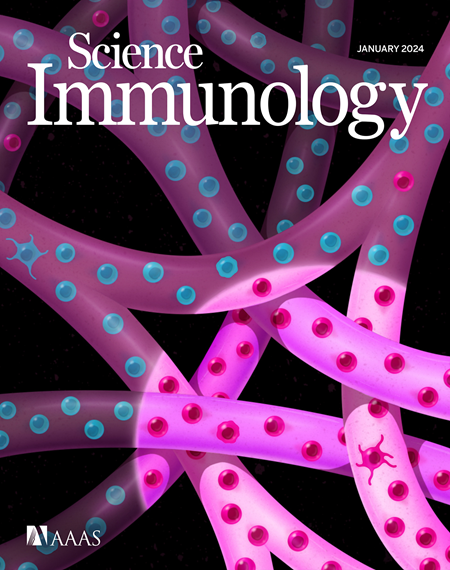GM-CSF–mediated epithelial-immune cell cross-talk orchestrates pulmonary immunity to Aspergillus fumigatus
IF 17.6
1区 医学
Q1 IMMUNOLOGY
引用次数: 0
Abstract
Aspergillus fumigatus causes life-threatening mold pneumonia in immunocompromised patients, particularly in those with quantitative or qualitative defects in neutrophils. Whereas innate immune cell cross-talk licenses neutrophil antifungal activity in the lung, the role of epithelial cells in this process is unknown. Here, we find that surfactant protein C (SPC)–expressing lung epithelial cells integrate infection-induced interleukin-1 and type III interferon signaling to produce granulocyte-macrophage colony-stimulating factor (GM-CSF) preferentially at local sites of fungal infection and neutrophil influx. Using in vivo models that distinguish the role of GM-CSF during acute infection from its homeostatic function in alveolar macrophage survival and surfactant catabolism, we demonstrate that epithelial-derived GM-CSF increases the accumulation and fungicidal activity of GM-CSF–responsive neutrophils, which is essential for host survival. Our findings establish SPC+ epithelial cells as a central player in regulating the quality and strength of neutrophil-dependent immunity against inhaled mold pathogens.

gm - csf介导的上皮免疫细胞串扰协调肺对烟曲霉的免疫
烟曲霉在免疫功能低下的患者中引起危及生命的霉菌肺炎,特别是在中性粒细胞有定量或定性缺陷的患者中。虽然先天免疫细胞的串扰允许中性粒细胞在肺中的抗真菌活性,但上皮细胞在这一过程中的作用尚不清楚。在这里,我们发现表达表面活性剂蛋白C (SPC)的肺上皮细胞整合感染诱导的白细胞介素-1和III型干扰素信号,在真菌感染和中性粒细胞内流的局部部位优先产生粒细胞-巨噬细胞集落刺激因子(GM-CSF)。利用体内模型,将GM-CSF在急性感染中的作用与其在肺泡巨噬细胞存活和表面活性剂分解代谢中的稳态功能区分开来,我们证明上皮来源的GM-CSF增加了GM-CSF反应性中性粒细胞的积累和杀真菌活性,这对宿主存活至关重要。我们的研究结果表明,SPC +上皮细胞在调节中性粒细胞依赖性免疫的质量和强度以抵抗吸入霉菌病原体方面发挥着核心作用。
本文章由计算机程序翻译,如有差异,请以英文原文为准。
求助全文
约1分钟内获得全文
求助全文
来源期刊

Science Immunology
Immunology and Microbiology-Immunology
CiteScore
32.90
自引率
2.00%
发文量
183
期刊介绍:
Science Immunology is a peer-reviewed journal that publishes original research articles in the field of immunology. The journal encourages the submission of research findings from all areas of immunology, including studies on innate and adaptive immunity, immune cell development and differentiation, immunogenomics, systems immunology, structural immunology, antigen presentation, immunometabolism, and mucosal immunology. Additionally, the journal covers research on immune contributions to health and disease, such as host defense, inflammation, cancer immunology, autoimmunity, allergy, transplantation, and immunodeficiency. Science Immunology maintains the same high-quality standard as other journals in the Science family and aims to facilitate understanding of the immune system by showcasing innovative advances in immunology research from all organisms and model systems, including humans.
 求助内容:
求助内容: 应助结果提醒方式:
应助结果提醒方式:


